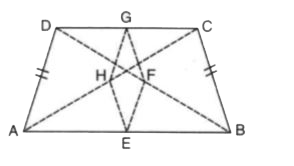Let ABCD is a square with sides of unit length. Points E and F are taken om sides AB and AD respectively so that AE= AF. Let P be a point inside the square ABCD.The maximum possible area of quadrilateral CDFE is-
1/8
1/4
5/8
3/8
The correct Answer is:C
To solve the problem, we need to find the maximum possible area of quadrilateral CDFE inside square ABCD, where AE = AF. Let's denote AE = AF = x.
1. Define the Square and Points:
- Let the vertices of square ABCD be:
- A(0, 1)
- B(1, 1)
- C(1, 0)
- D(0, 0)
- Points E and F are on sides AB and AD respectively:
- E(0, 1 - x)
- F(x, 1)
2. Area of Quadrilateral CDFE:
- The area of quadrilateral CDFE can be calculated using the formula:
Area of CDFE=Area of ABCD−Area of △AFE−Area of △BCE
3. Calculate Area of Square ABCD:
- The area of square ABCD is:
Area of ABCD=1×1=1 square unit
4. Calculate Area of Triangle AFE:
- Triangle AFE is a right triangle with base AF and height AE:
Area of △AFE=12×AE×AF=12×x×x=x22
5. Calculate Area of Triangle BCE:
- The base BE is (1 - x) and the height is 1:
Area of △BCE=12×BE×BC=12×(1−x)×1=1−x2
6. Combine Areas:
- Now, substituting the areas into the equation for CDFE:
Area of CDFE=1−(x22+1−x2)
- Simplifying this gives:
Area of CDFE=1−(x2+1−x2)=1−x2−x+12
- This can be rewritten as:
A=2−x2+x−12=−x2+x+12
7. Maximize the Area:
- To maximize the area A, we differentiate with respect to x:
A′=12(−2x+1)
- Setting the derivative to zero for critical points:
−2x+1=0⟹x=12
8. Check for Maximum:
- To confirm it's a maximum, we check the second derivative:
A′′=−1<0
- Since A'' is negative, x = 1/2 is indeed a maximum.
9. Calculate Maximum Area:
- Substitute x = 1/2 back into the area formula:
A(12)=−(12)2+12+12=−14+12+12=−14+24+442=542=58
Final Answer:
The maximum possible area of quadrilateral CDFE is 58.
- Let the vertices of square ABCD be:
- A(0, 1)
- B(1, 1)
- C(1, 0)
- D(0, 0)
- Points E and F are on sides AB and AD respectively:
- E(0, 1 - x)
- F(x, 1)
- The area of quadrilateral CDFE can be calculated using the formula:
Area of CDFE=Area of ABCD−Area of △AFE−Area of △BCE
- The area of square ABCD is:
Area of ABCD=1×1=1 square unit
- Triangle AFE is a right triangle with base AF and height AE:
Area of △AFE=12×AE×AF=12×x×x=x22
- The base BE is (1 - x) and the height is 1:
Area of △BCE=12×BE×BC=12×(1−x)×1=1−x2
- Now, substituting the areas into the equation for CDFE:
Area of CDFE=1−(x22+1−x2)
- Simplifying this gives:
Area of CDFE=1−(x2+1−x2)=1−x2−x+12
- This can be rewritten as:
A=2−x2+x−12=−x2+x+12
- To maximize the area A, we differentiate with respect to x:
A′=12(−2x+1)
- Setting the derivative to zero for critical points:
−2x+1=0⟹x=12
- To confirm it's a maximum, we check the second derivative:
A′′=−1<0
- Since A'' is negative, x = 1/2 is indeed a maximum.
- Substitute x = 1/2 back into the area formula:
A(12)=−(12)2+12+12=−14+12+12=−14+24+442=542=58
The maximum possible area of quadrilateral CDFE is 58.
Topper's Solved these Questions
- COORDINATE SYSYEM Book:CENGAGE ENGLISHChapter:COORDINATE SYSYEM Exercise:Matrix match type
Explore 4 Videos
- COORDINATE SYSYEM Book:CENGAGE ENGLISHChapter:COORDINATE SYSYEM Exercise:Numerical value
Explore 12 Videos
- COORDINATE SYSYEM Book:CENGAGE ENGLISHChapter:COORDINATE SYSYEM Exercise:Multiple correct
Explore 13 Videos
- COORDINATE SYSTEMBook:CENGAGE ENGLISHChapter:COORDINATE SYSTEMExercise:Multiple Correct Answers Type
Explore 2 Videos
- CROSS PRODUCTS Book:CENGAGE ENGLISHChapter:CROSS PRODUCTS Exercise:DPP 2.2
Explore 13 Videos
Similar Questions
Let ABCD be a square with sides of unit lenght. Points E and F are taken on sides AB and AD, respectively,so that AE=AF. Let P be a point inside the squre ABCD.
Let a line passing through point A divides the sqaure ABD into two parts so that the area of one portion is double the other. then the length of the protion of line inside the square is
View SolutionLet ABCD be a square with sides of unit lenght. Points E and F are taken on sides AB and AD, respectively,so that AE=AF. Let P be a point inside the squre ABCD.
The value of (PA)2−(PB)2+(PC)2−(PD)2 is equal to
View SolutionABCD is a parallelogram. Two points P and Q are taken on sides AD and BC respectively such that AP 13ADandCQ=13BC. Prove that □AQCP is a parallelogram.
View SolutionABCD is a square. P, Q and Rare the points on AB, BC and CD respectively, such that AP = BQ = CR. Prove that:
PQ = QR
View SolutionABCD is a square. P, Q and Rare the points on AB, BC and CD respectively, such that AP = BQ = CR. Prove that:
PB = QC
View SolutionABCD is a square, X and Y are points on sides AD and BC respectively such that AY=BX. Prove that BY=AX and ∠BAY=∠ABX.
View SolutionABCD is a quadrilateral in which AD = BC. E, F, G and H are the mid-points of AB, BD, CD and AC respectively. Prove that EFGH is a rhombus.

View SolutionABCD is a parallelogram. P and Q are the mid-points of sides AB and AD reapectively.
Prove that area of triangle APQ= 18 of the area of parallelogram ABCD.
View SolutionABCD is a parallelogram. P and Q are the mid-points of sides AB and AD reapectively.
Prove that area of triangle APQ= 18 of the area of parallelogram ABCD.
View SolutionIn a parallelogram ABCD, E and F are the mid-points of sides BC and AD respectively. Show that the line segment BF and ED trisect the diagonal AC.
View Solution

